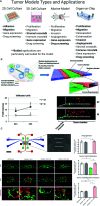Advances in Modeling the Immune Microenvironment of Colorectal Cancer
- PMID: 33643296
- PMCID: PMC7902698
- DOI: 10.3389/fimmu.2020.614300
Advances in Modeling the Immune Microenvironment of Colorectal Cancer
Abstract
Colorectal cancer (CRC) is the third most common cancer and second leading cause of cancer-related death in the US. CRC frequently metastasizes to the liver and these patients have a particularly poor prognosis. The infiltration of immune cells into CRC tumors and liver metastases accurately predicts disease progression and patient survival. Despite the evident influence of immune cells in the CRC tumor microenvironment (TME), efforts to identify immunotherapies for CRC patients have been limited. Here, we argue that preclinical model systems that recapitulate key features of the tumor microenvironment-including tumor, stromal, and immune cells; the extracellular matrix; and the vasculature-are crucial for studies of immunity in the CRC TME and the utility of immunotherapies for CRC patients. We briefly review the discoveries, advantages, and disadvantages of current in vitro and in vivo model systems, including 2D cell culture models, 3D culture systems, murine models, and organ-on-a-chip technologies.
Keywords: cancer immunology; colorectal cancer; organ-on-a-chip (OOC); tissue engineering; tumor microenvironment.
Copyright © 2021 Yoon, Del Piccolo, Shirure, Peng, Kirane, Canter, Fields, George and Gholami.
Conflict of interest statement
SCG is co-founder of Aracari Biosciences, a start-up company focused on the commercialization of vascularized OOC technology. The remaining authors declare that the research was conducted in the absence of any commercial or financial relationships that could be construed as a potential conflict of interest.
Figures

References
Publication types
MeSH terms
Grants and funding
LinkOut - more resources
Full Text Sources
Other Literature Sources
Medical

